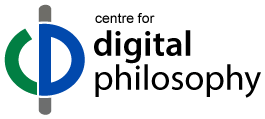Interpretação de atos de fala
Metáforas e o papel da abdução
DOI:
https://doi.org/10.15448/1984-6746.2022.1.40490Palavras-chave:
Interpretação, Atos de fala, Intencionalidade, Abdução, MetáforasResumo
Neste artigo apresentamos de forma breve uma teoria searliana de interpretação dos atos de fala. Mostramos através do exemplo das metáforas que, conforme proposta por Searle, a interpretação de atos de fala consistiria em reconhecer a intenção do falante. Esse processo se daria por meio do uso de regras convencionais da linguagem tanto pelo falante quanto pelo ouvinte. Contudo, as metáforas são um exemplo de que essa proposta de interpretação não é suficiente para descrever o processo pelo qual os agentes interpretam atos de fala. Argumentamos que se deve acrescentar a esse processo a noção de regras estratégicas. Seguindo Peirce, duas regras estratégicas são oferecidas: o princípio da coerência e o princípio da economia. Parece também satisfatório acrescentar o princípio da não-contradição. Embora estudos empíricos não sejam definitivos sobre o tema da interpretação, em especial sobre metáforas, os resultados apontam para a aplicação de regras estratégicas na interpretação. Finalmente, é sugerido que se Searle está certo ao dizer que interpretação é o reconhecimento da intenção do falante, então a interpretação depende do uso de regras convencionais e do uso de regras estratégicas.
Downloads
Referências
ALONSO, Bernardo. A tese da veracidade na teoria da informação fortemente semântica de Floridi e o paradoxo de Bar-Hillel-Carnap. Veritas, Porto Alegre, v. 57, n. 2, p. 123-142, 2012. DOI: https://doi.org/10.15448/1984-6746.2012.2.10568
COLSTON, Helbert; GIBBS, Raymond Jr. Metaphor processing. In: SEMINO, Elena; DEMJÉN, Zsófia. The Routledge handbook of metaphor and language. New York: Routledge, 2017. p. 457-472.
CHOMSKY, Noam. Estruturas sintáticas. Petrópolis: Vozes, 2018.
ECO, Umberto. Semiótica e filosofia da linguagem. Lisboa: Instituto Piaget, 1984.
FLORIDI, Luciano. In defense of the veridical nature of semantic information. European Journal of Analytic Philosophy, Rijeka, v. 3, n. 1, p. 31-41, 2007.
GENTNER, Dedre; BOWDLE, Brian. Metaphor as structure-mapping. In: GIBBS, Raymond. The Cambridge handbook of metaphor and thought. Cambridge: Cambridge University Press, 2008. p. 109-128. DOI: https://doi.org/10.1017/CBO9780511816802.008
GIORA, Rachel. Is metaphor unique? In: GIBBS, Raymond. The Cambridge handbook of metaphor and thought. Cambridge: Cambridge University Press, 2008. p. 141-160. DOI: https://doi.org/10.1017/CBO9780511816802.010
GLUCKSBERG, Sam. The psycholinguistics of metaphor. Trends in Cognitive Science, Amsterdam, v. 7, n. 2, p. 92-96, 2003. DOI: https://doi.org/10.1016/S1364-6613(02)00040-2
GLUCKSBERG, Sam; GILDEA, Patricia; BOOKIN, Howard. On understanding nonliteral speech: can people ignore metaphors? Journal of Verbal Learning and Verbal Behavior, Amsterdam, v. 21, p. 85-98, 1982. DOI: https://doi.org/10.1016/S0022-5371(82)90467-4
GLUCKSBERG, Sam; NEWSOME, Mary; GOLDVARG, Yevgeniya. Inhibition of the literal: filtering metaphor-irrelevant information during metaphor comprehension. Metaphor and Symbol, London, v. 16, n. 4, p. 277-293, 2001. DOI: https://doi.org/10.1207/S15327868MS1603&4_8
HASSON, Uri; GLUCKSBERG, Sam. Does understanding negation entail affirmation? Journal of Pragmatics, Amsterdam, v. 38, p. 1015-1032, 2006. DOI: https://doi.org/10.1016/j.pragma.2005.12.005
HINTIKKA, Jaakko. Socratic epistemology: explorations of knowledge-seeking by questioning. Cambridge: Cambridge University Press, 2007. DOI: https://doi.org/10.1017/CBO9780511619298
JOHNSON, Mark. Philosophy’s debt to metaphor. In: GIBBS, Raymond. The Cambridge handbook of metaphor and thought. Cambridge: Cambridge University Press, 2008. p. 19-52. DOI: https://doi.org/10.1017/CBO9780511816802.004
KATZ, Albert. Psycholinguistic approaches to metaphor acquisition and use. In: SEMINO, Elena.; DEMJÉN, Zsófia. The routledge handbook of metaphor and language. New York: Routledge, 2017. p. 457-471.
LAKOFF, George. The neural theory of metaphor. In: GIBBS, Raymond. The Cambridge handbook of metaphor and thought. Cambridge: Cambridge University Press, 2008. p. 17-38. DOI: https://doi.org/10.1017/CBO9780511816802.003
LAKOFF, George; JOHNSON, Mark. Metaphors we live by. Chicago: The University of Chicago Press, 2003. DOI: https://doi.org/10.7208/chicago/9780226470993.001.0001
MAGNANI, Lorenzo. Abductive cognition: the epistemological and eco-cognitive dimensions of hypothetical reasoning. Berlin: Springer, 2009. DOI: https://doi.org/10.1007/978-3-642-03631-6
MAITRA, Ishani. The nature of epistemic injustice. Philosophical books, New Jersey, v. 51, n. 4, p. 195-211, 2010. DOI: https://doi.org/10.1111/j.1468-0149.2010.00511.x
PEIRCE, Charles Sanders. (CP) Collected Papers of Charles Sanders Peirce. 8 vols. Cambridge: Harvard University Press, 1931-1958. 8 v.
SEARLE, John R. Speech Acts: an essay in the philosophy of language. New York: Cambridge University Press, 1969. DOI: https://doi.org/10.1017/CBO9781139173438
SEARLE, John R. Expression and meaning: studies in the theory of speech acts. New York: Cambridge University Press, 1979. DOI: https://doi.org/10.1017/CBO9780511609213
SEARLE, John R. Intentionality: an essay in the philosophy of mind. New York: Cambridge University Press, 1983. DOI: https://doi.org/10.1017/CBO9781139173452
SEARLE, John R. Mind, language, and society: philosophy in the real world. New York: Basic Books, 1998.
VAN BERKUM, Jos. Understanding sentences in context: what brain waves can tell us. Current directions in Psychological Science, Thousand Oaks, v. 17, n. 6, p. 376-380, 2008. DOI: https://doi.org/10.1111/j.1467-8721.2008.00609.x
Downloads
Publicado
Como Citar
Edição
Seção
Licença
Copyright (c) 2022 Veritas (Porto Alegre)

Este trabalho está licenciado sob uma licença Creative Commons Attribution 4.0 International License.
Direitos Autorais
A submissão de originais para a Revista Veritas implica na transferência, pelos autores, dos direitos de publicação. Os direitos autorais para os artigos publicados nesta revista são do autor, com direitos da revista sobre a primeira publicação. Os autores somente poderão utilizar os mesmos resultados em outras publicações indicando claramente a Revista Veritas como o meio da publicação original.
Licença Creative Commons
Exceto onde especificado diferentemente, aplicam-se à matéria publicada neste periódico os termos de uma licença Creative Commons Atribuição 4.0 Internacional, que permite o uso irrestrito, a distribuição e a reprodução em qualquer meio desde que a publicação original seja corretamente citada. Copyright: © 2006-2020 EDIPUCRS



















